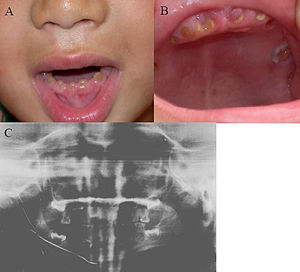Dentinogenesis imperfecta
| Dentinogenesis imperfecta | |
|---|---|
 |
|
| Classification and external resources | |
| ICD-10 | K00.5 |
| ICD-9-CM | 520.5 |
| MeSH | D003811 |
Dentinogenesis imperfecta (DI) is a genetic disorder of tooth development. This condition is a type of dentin dysplasia that causes teeth to be discolored (most often a blue-gray or yellow-brown color) and translucent giving teeth an opalescent sheen. Teeth are also weaker than normal, making them prone to rapid wear, breakage, and loss. These problems can affect both primary (deciduous) teeth and permanent teeth. This condition is inherited in an autosomal dominant pattern, which means one copy of the altered gene in each cell is sufficient to cause the disorder. Dentinogenesis imperfecta affects an estimated 1 in 6,000 to 8,000 people.
Type I: Type of dentinogenesis imperfecta with similar dental abnormalities usually an autosomal dominant trait with variable expressivity but can be recessive if the associated osteogenesis imperfecta is of recessive type.
Type II : Occurs in people without other inherited disorders (i.e. Osteogenesis imperfecta). It is an autosomal dominant trait. A few families with type II have progressive hearing loss in addition to dental abnormalities. Also called hereditary opalescent dentin.
Type III: Type is rare; its predominant characteristic is bell-shaped crowns, especially in the permanent dentition. Unlike Types I and II, it involves teeth with shell-like appearance and multiple pulp exposures.
Mutations in the DSPP gene have been identified in people with type II and type III dentinogenesis imperfecta. Type I occurs as part of osteogenesis imperfecta.
Clinical appearance is variable. However, the teeth usually involved and more severely affected are primary teeth in type I; whereas in type II both the dentitions are equally affected.
The teeth may be gray to yellowish brown. They exhibit translucent or opalescent hue. Enamel is usually lost early due to loss of scalloping at the dentoenamel junction (DEJ). However, the teeth are not more susceptible to dental caries than normal ones.
However, certain patients with dentinogenesis imperfecta will suffer from multiple periapical abscesses apparently resulting from pulpal strangulation secondary to pulpal obliteration or from pulp exposure due to extensive coronal wear. They may need apical surgery to save the involved teeth.
...
Wikipedia
